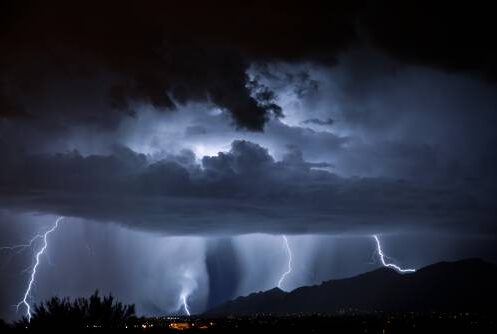Surge protection is one of the most basic investments for a home electrical system. The goal of surge protection is to prevent spikes in the system’s electrical load from reaching a critical point that could damage appliances, wiring and devices. Homeowners need to understand the basics of surge protection so they can appropriately address issues with their property’s electrical systems.
What Is Surge Protection?
An electrical surge happens when an unexpectedly high level of electricity floods a system. The classic example of an electrical surge is when lighting hits a house. The electricity from the bolt of lightning is seeking a path to the ground. It wants to go through the house so it can discharge into the ground like it would if it had hit open terrain. In the meantime, that electricity goes through everything between the lightning’s strike point and the ground. This is why a high-standing system like an antenna needs its own ground wire to direct the electricity as quickly as possible to the Earth.
There are plenty of less dramatic examples of electrical surges. A power tool can experience a surge for a host of reasons, such as a malfunctioning motor or operator misuse. The extra electricity has to go somewhere. Typically, a plugged-in tool will send a surge to the house’s grounding system.
Surges also can push through the nearby electrical system into your home. A surge could happen if a nearby transformer malfunctions. The failure of the transformer can create a condition where a buildup of power has to go somewhere. Without a better path, the surge could go into the neighboring homes.
Just about every electrical device in your home has some surge risk. Some systems create surge risks because they need to build charges. For example, many HVAC systems and refrigerators have to power up to begin their operating cycles. Also, anything connected to the electrical system can be at risk. This includes everything from EV charging stations to your phone plugged into a USB adapter.
Is Surge Protection Necessary?
Homes have many systems that address surges in limited ways. The grounding system provides a path through the third prong on electrical cords, for example. Likewise, modern breakers in electrical panels provide limited protection against minor surges.
However, these systems don’t protect against major surges. A surge from a utility grid switching issue could push 10,000 amps. That is pushing the envelope of what your home’s grounding system may or may not survive.
Likewise, systems like breakers are meant to protect upstream devices from relatively minor draws. If your home’s HVAC pulls too much energy, the breaker flips off at its rated amperage. However, the manufacturer of a 20-amp breaker never meant it to survive tens of thousands of amps. In other words, breakers don’t serve as surge protection systems.
Also, the grounding system is prone to variable performance due to environmental conditions. Wetter soil generally serves as a better ground. A period of prolonged low humidity, a common event in the region around Wheat Ridge, can reduce the grounding system’s peak capacity in amps. Also, the soil itself makes a difference. Various minerals in some soils provide better or worse grounding. Consequently, you can’t depend on the grounding system alone to serve as your home’s surge protection system.
How Does Surge Protection Work?
To the extent that many people are familiar with surge protection, it usually relates to power strips. These systems use variable resistors and fuses that detect surges and then direct the extra electricity to the home’s ground. Notably, strip-based solutions provide limited protection. They cover limited areas and rely on the home’s ground to redirect the surge. The resistors can absorb some of the hit, but that is also a limited system.
When we talk about surge protection as electricians, we are generally talking about a whole-home system. A whole-home system does apply some of the principles of a power strip. However, it does so at a much greater capacity. For example, the variable resistors in the system have larger capacities. These allow the surge protection system to absorb more amps while the electric current flows to the ground.
Similarly, every whole-home surge protection setup should include a thermal disconnect. This uses a heat-sensitive element to break the electrical connection once the temperature hits a certain threshold. This can prevent surging electricity from continuing to enter your home’s electrical system.
You will find some systems that use additional components like gas discharge tubes and silicon avalanche diodes. However, these only add additional fail-safes and capacity to the overall surge protection system.
How Much Surge Protection Does Your Home Need?
The typical range for a whole-home surge protection system is between 40,000 and 80,000 amps. This is more than enough for the system to survive anything originating from your own devices or the electrical grid. A direct lightning strike on your house will push something like 200,000 amps. However, this is unlikely in most areas. Also, the best solution if you live at a location that’s prone to lightning strikes is to install a lightning rod with its own grounding line.
Some factors will affect how robust the surge protection setup ought to be. The more large-capacity electrical devices that are present in your system, the more surge protection you want. Suppose your house has a big HVAC, a fridge, a separate freezer and an EV charging station. There is an argument for that kind of high-demand household to install more surge protection capacity.
The history of your location also matters. If the electrical company has had lots of problems with your section of the grid, then the wise move is to have more surge capacity. Anyone unsure about the history in their neck of the woods is welcome to discuss their options with our experienced electricians.
Your Reliable Electrical Experts
Mighty Pine Heating & Air is a contracting firm that proudly serves the Wheat Ridge area and the surrounding Denver metro area. We are a family-owned and locally run business that provides heating and air conditioning services in addition to doing electrical work. Our electricians are prepared to handle jobs ranging from installing outdoor lighting to performing electrical panel upgrades. People trust us because we’re a licensed business that holds an A+ rating with Better Business Bureau. There are also numerous testimonials available on our website so you can see what your neighbors have to say about our company.
If you have questions about surge protection, electrical work or HVAC systems, we would be glad to answer them. We frequently offer specials. Likewise, financing is available to all qualified customers so cost should never be an issue when it comes to doing what’s right for your home. Setting up the right surge protection system for your home is critical to protecting your investment. Contact Mighty Pine Heating & Air today to find out more about the available options and to ask one of our skilled electricians to assess your home’s needs.



